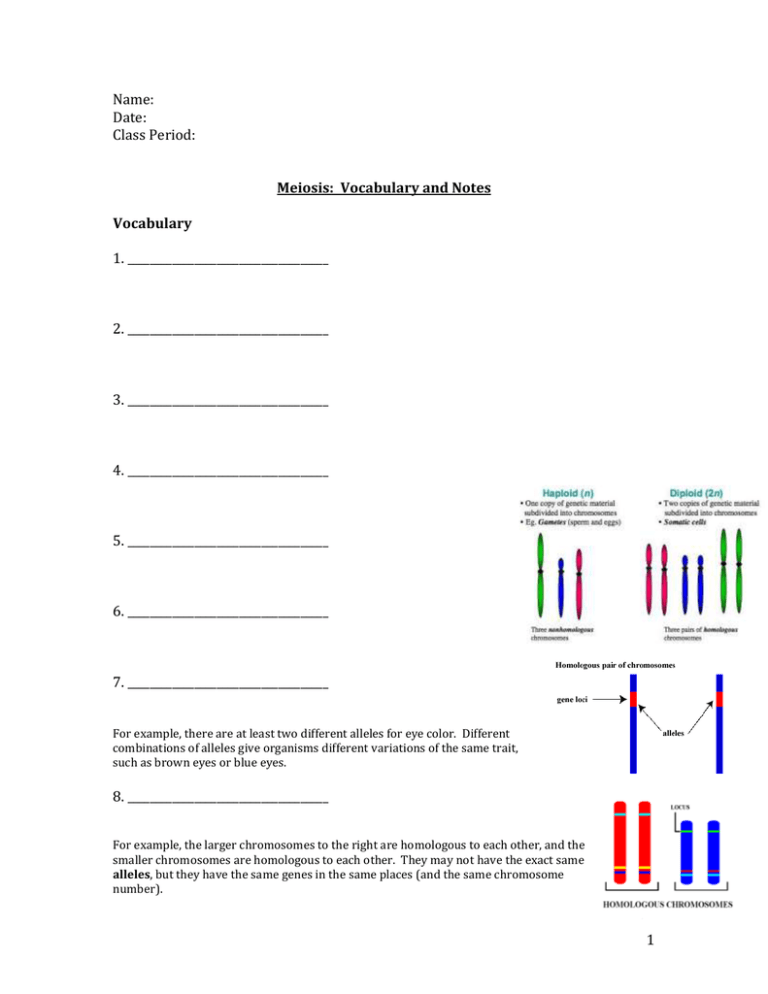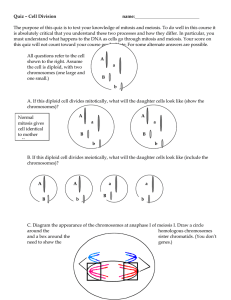Name: Date: Class Period: Meiosis: Vocabulary and Notes
advertisement

Name: Date: Class Period: Meiosis: Vocabulary and Notes Vocabulary 1. ____________________________________ 2. ____________________________________ 3. ____________________________________ 4. ____________________________________ 5. ____________________________________ 6. ____________________________________ 7. ____________________________________ For example, there are at least two different alleles for eye color. Different combinations of alleles give organisms different variations of the same trait, such as brown eyes or blue eyes. 8. ____________________________________ For example, the larger chromosomes to the right are homologous to each other, and the smaller chromosomes are homologous to each other. They may not have the exact same alleles, but they have the same genes in the same places (and the same chromosome number). 1 9. ____________________________________ In the picture on the previous page, the large and small chromosomes are non-homologous because they carry different genes. 10. ____________________________________ 11. ____________________________________ 12. ____________________________________ 13. ____________________________________ 14. ____________________________________ 15. ____________________________________ 16. ____________________________________ 17. ____________________________________ 2 Key Point #1: Mitosis and Meiosis are two different types of cell division. -Mitosis creates two _______________________ ________________________ cells from one __________________________ cell -ALL of your ________________________________ cells do mitosis -after mitosis, the daughter cells have the same number of ________________________ as the parent cell (2n 2n) -Meiosis creates ____________ unique daughter cells from _______________ parent cell -Meiosis is ONLY used to make ________________ cells -each daughter cell has ______________________________ the number of chromosomes as the parent cell (2nn) 3 Key Point #2: Mitosis is cell division that results in two diploid cells that are identical to the original cell. 1. The diploid (2n) parent cell replicates its DNA to go from __-shaped to ___-shaped double ___________________________________ 2. The parent cell divides (splitting the X shaped double _________________________ into I-shaped single _________________________) to create two identical cells that are both ____________. Do you want all of your skin cells to be different, or the same? Why? Check for Understanding 1. If a skin cell with 46 chromosomes undergoes mitosis, how many chromosomes will each daughter cell have? 2. If two daughter cells in a cabbage leaf have 18 chromosomes each, how many chromosomes did the parent cell have? 4 Key Point #3: Meiosis is two cell divisions that results in four haploid, nonidentical daughter cells. • Step 1: The parent cell _______________________ (copies) its DNA. The chromosomes have gone from I shaped to X shaped. This cell is still considered ______________________(Why?). • Step 2: The parent cell divides to make two ___________________ daughter cells (the X shaped ________________________ split up) • Step 3: Each daughter cell ___________________. The X shaped chromosomes split into I shaped chromosomes to make a total of ______ haploid daughter cells. 5 Key Point #4: Meiosis only happens in reproductive organs to create sex cells In females, meiosis happens in the _______________________ to create ______________cells. In males, meiosis happens in the ______________________ to make __________________ cells. Egg and sperm cells are called _________________________. Meiosis Diagram You will need to know this. -The parent cell is ______________________ (2n) and has 2 of each chromosome. -After the DNA duplicates and the chromosomes are ____ shaped, the cell is still considered diploid. -The parent cell divides and one chromosome from each pair goes to each cell. The daughter cells are now haploid, but the chromosomes are still in duplicate form, so they are still ___-shaped. -Each ______________________ (n) cell divides into 2 daughter cells that are also haploid (the duplicated X shaped chromosomes separate into I shaped chromosomes) 6 Filling in the Diagram In humans, this is the number of chromosomes in each cell during meiosis. So what about frogs? Frogs are diploid and have 26 chromosomes in their somatic cells. Fill in this meiosis diagram for Sparky. 7 Check for Understanding Fill in the meiosis diagram for coyotes. Coyotes are diploid and have 76 chromosomes in their somatic cells. If a human somatic cell has 46 chromosomes, how many chromosomes would there be in a human cell after meiosis? If a goat gamete produced during meiosis has 30 chromosomes, how many chromosomes would a goat skin cell have? Assume goats are diploid. 8






